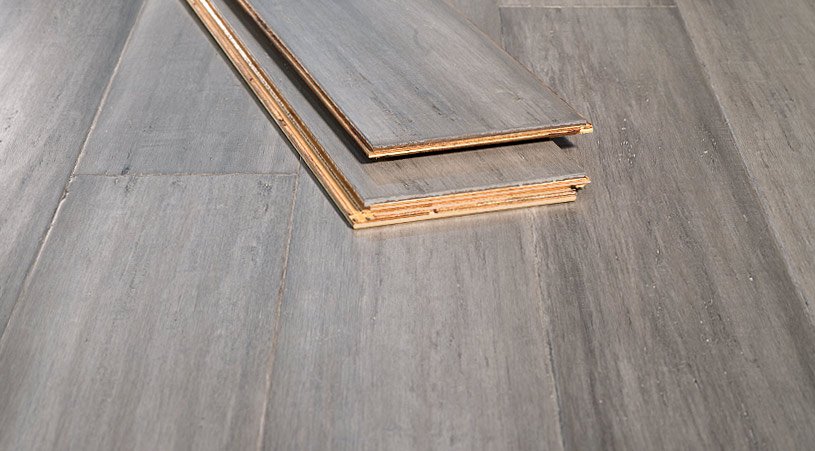
Bamboo flooring is renowned for lots of house owners due to its benefits. It has ended up being the major choiced floor for company and home owners whenever there is need for sustainability.
Nevertheless, bamboo much like timber, is prone to damages and also breaking when humidity levels change.
Are you believing regarding bamboo flooring for your house? We will also discuss the different types of bamboo flooring available on the market.
Sorts Of Bamboo Flooring
There are three fundamental options: strand-woven, vertical, and also straight. Homeowners can choose which type of bamboo flooring to purchase based upon their traits. The purchaser's intended aesthetic effects the selected Bamboo flooring type.
Engineered Bamboo Flooring
Both solid and engineered bamboo flooring options are offered. As soon as the bamboo timber fits, it isn't easy to distinguish between them.
But their differences are because of their making. Crafted bamboo timber has a slim plywood backing.
Whether engineered or strong, bamboo flooring is strong, resistant, as well as attractive.
Engineered bamboo flooring uses the floating timber floor over a slim foam base. They may likewise be in the form of vast planks. As an example, they are available in widths approximately 19 centimeters.
Solid - Straight Bamboo Flooring
You will observe that this type is nearly the like vertical bamboo flooring. However it has a slight variation. Horizontal bamboo is one of the most popular kinds of bamboo flooring.
It is made by drying out substantial strips of bamboo, cutting these larger pieces into thinner strips, and then gluing them to form planks. The boards will then be subject to pressure as well as warm to ensure they are well secured.
Natural bamboo has a lighter color. Thus, the strips are frequently discolored. While carbonized bamboo will certainly be much less difficult than regular bamboo, if you need a darker color, it may do you excellent. It additionally offers the natural bamboo looks and a selection of alternatives.
Strand Woven Bamboo Flooring
Shredding the bamboo to draw out the fibers is among the more drawing steps in generating strand-woven bamboo floorings.
The bamboo fiber is usually combined with an adhesive after it's made to a pulp. The material is after that weaved and compressed under fantastic warm, as the name recommends.
After making upright and straight bamboo, the strips serve to create hair woven bamboo. The eco-conscious buyer might find this feature appealing. The factor is that it makes certain that the entire bamboo stalk produces very little waste.
Solid - Vertical Bamboo Flooring
Thin strips of dry bamboo wood glued up and down and pushed utilizing high warmth and also stress produce this type of bamboo flooring.
The thinnest side of the bamboo planks will certainly be in a vertical type. A firm bonding, pressing, as well as lamination will certainly comply with. As a result of their approach of joining, the bamboo strips include a slim grain pattern.
The good idea regarding this sort of bamboo flooring is that it is sturdy and also really budget friendly. It provides a classy as well as classy floor coating. However it is not commonly readily available.
Functions And Also What to Remember When Choosing Bamboo Flooring
With a multi-layered coating, bamboo flooring will certainly be pretty resilient. Maintain in mind that future touch-ups may require an extra experienced flooring expert.
Also, applying your coating will make matching fixings less complicated when established in your home. But the finish will certainly not last as long as factory surfaces.
In addition to that, right here are some amazing functions of bamboo flooring.
Eco-Conscious
This flooring originates from a natural plant called the bamboo plant. When compared to various other tree species used to make hardwood flooring, bamboo grows more and much faster.
Affordable Upkeep
You can maintain bamboo flooring in good condition by cleaning and damp mopping. Despite being more susceptible to scratches, bamboo flooring is really straightforward to maintain.
You may get bamboo floorings that are as good as new by sanding them down as well as using a fresh layer of paint.
Resilient
Bamboo flooring is not produced equivalent. There are many types of bamboo, and the various techniques utilized to transform it into slabs impact its toughness.
As such, bamboo, like hardwood flooring, can become susceptible to tear and also use over time. Likewise, damaging, splitting, and other damage may occur. You can additionally sand some bamboo to resemble hardwood, but not all.
Bottom Line
It's basic to know why bamboo flooring has actually become much more popular nowadays. For almost any type of residence, bamboo uses numerous strong as well as sound services for the atmosphere. Bamboo floor may be the ideal alternative for upgrading your flooring.
We will additionally review the various types of bamboo flooring offered on the market. Property owners can choose which kind of bamboo flooring to buy based on their attributes. Horizontal bamboo is one of the most prominent types of bamboo flooring.
While carbonized bamboo will be much less hard than regular bamboo, if you require a darker color, it may do you excellent. After making horizontal as well as upright bamboo, the strips serve to create hair woven bamboo.
Bamboo Flooring
Manufacture of Bamboo Flooring
Stranded bamboo is made by shredding the bamboo stalks into small strands, which are compressed into sheets using heat and resin binders, then cut into planks to use as building materials. This form of flooring is available both as tongue-and-groove planks that are nailed down, as well as planks that float over the underlayment. This is a premium form of bamboo flooring, available in many colors.
Horizontal bamboo flooring is manufactured by cutting the strands into thin strips which are then glued together to form planks. This type of flooring has a "grain," since the long stalk fibers are visible in the flooring. This type of bamboo is not as hard or durable as stranded bamboo, but it can have a very striking appearance. It, too, is available both in nail-down planks and as floating floor planks.
Engineered bamboo flooring is made by bonding a thin layer of bamboo onto a plywood or MDF core. This flooring is comparable to engineered hardwood and is installed in the same way—usually with click-lock planks that float over a foam underlayment. It is the least expensive (and least durable) form of bamboo flooring, and it cannot be refinished.
Unless it is stained, most bamboo flooring has a natural blonde or amber color that resembles unfinished maple or birch, but darker tones are available through a process called carbonizing, which entails subjecting the planks to high temperatures. While the color can be very attractive, carbonized bamboo is softer than uncarbonized forms, and is more susceptible to scratching.
Eco-Friendliness
Environmentally conscious consumers are often drawn to bamboo as a wholly renewable resource. Unlike the hardwood lumber industry, where trees can take decades to mature, bamboo stalks grow so fast that there is little environmental liability to the harvest practices. Moreover, bamboo stalks that are cut simply continue to grow and replenish themselves so that they can be harvested.
But the manufacturing process creates other environmental concerns. Bamboo floor planks are manufactured by slicing or shredding the stalks of bamboo grass plants and then compressing the pulp back together using heat, pressure, and a resin-based adhesive identical to those used in many other flooring products. This adhesive often contains urea-formaldehyde that can outgas into the air.1
The level of adhesive used and the amount of toxins emitted will vary, depending on how the bamboo planks are manufactured. Cheaper products may contain more formaldehyde, while more expensive products may use alternative materials in the resins. The amount of formaldehyde used in bamboo flooring is similar to that found in engineered hardwood flooring or MDF sheathing, and it tends to be a problem only for sensitive individuals.2 But if this concerns you, look for bamboo products labeled as formaldehyde-free.
Bamboo Flooring Cost
This material is priced at about the same level as most hardwood floors. You can find bamboo flooring products ranging from about $2 to $8 per square foot, with a national average of $3.84 per square foot. Installation costs for bamboo flooring are much the same as for hardwood flooring. On average, figure on adding about $4 per square foot for installation labor in addition to the cost of materials. You should be able to get a good-quality bamboo installed for less than $10 per square foot, including materials and labor.
https://www.thespruce.com/benefits-and-drawbacks-of-bamboo-floors-1314694

Do you appreciate reading up on How To Install Bamboo Flooring? Post a review down the page. We'd be delighted to find out your opinion about this write-up. Hoping that you come back again soon. In case you enjoyed our page if you please remember to pass it around. Thank you so much for taking the time to read it.